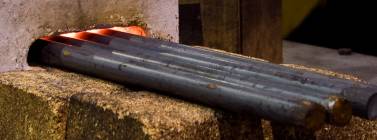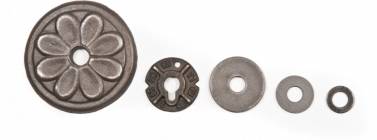Is it possible to manufacture an A325 or A490 structural bolt with a non-standard thread length?

Yes. At Portland Bolt we are frequently asked this question. In order to better understand the answer, some background information on these two specifications is necessary. Both the A325 and the A490 specifications cover high strength, heavy hex, structural bolts from ½” diameter through 1½” in diameter. Both ASTM A325 and A490 specify shorter thread lengths than the standard thread formula, because these bolts are used for steel-to-steel connections and the grip length (amount of unthreaded bolt shank) is critical due to the fact that depending on the type of connection, it may be undesirable for threads to extend into the shear plane. In both specifications, the amount of thread on the bolt is tied to the bolts diameter. This can be seen in the A325/A490 thread chart below:
| Nominal Bolt Size (in.) | 1⁄2 | 5⁄8 | 3⁄4 | 7⁄8 | 1 | 11⁄8 | 11⁄4 | 13⁄8 | 11⁄2 |
|---|---|---|---|---|---|---|---|---|---|
| Thread Length (in.) | 1.00 | 1.25 | 1.38 | 1.50 | 1.75 | 2.00 | 2.00 | 2.25 | 2.25 |
There is a supplement in the A325 specification that allows A325 heavy hex bolts to be fully threaded. The S1 supplement states that A325 “bolts with nominal lengths equal to or shorter than four times the nominal bolt diameter shall be threaded full length.” When A325 bolts are manufactured as fully threaded under this supplementary requirement, they must be marked “A325T“. These fully threaded A325 bolts are sometimes referred to as “A325 tap bolts” or simply “tap” bolts.
So how is it possible to manufacture an A325 or A490 structural bolt with a non-standard thread length?
There are two ways to address this problem. The first solution, as is often the case, can be found in the specifications themselves. Both the A325 and the A490 specification direct you to go to another specification when you need a similar bolt with differing configurations. In Section 1.5 of the A325 specification it states “for bolts of other configurations and thread lengths with similar mechanical properties (to A325), see Specification A449.” In Section 8.1.2 of the A490 specification it states “bolts requiring thread lengths other than those required by this specification shall be ordered under Specification A354 Gr. BD.”
So, if you want to put non-standard thread length on an A325 or A490 bolt, the first option is to switch to an A449 or A354 Grade BD bolt, respectively. Our knowledgeable sales staff here at Portland Bolt will often walk customers through these exact portions of the A325 and A490 specifications in order to present the possibility of moving specifications on a bolt order to accommodate non-standard thread lengths. However, our experienced team of estimators also understands that many customers are not well versed in the world of fastener specifications and may find all of this very confusing. We also understand the realities of the construction world and are aware of the headaches and difficulties that may often be involved in getting approval from a project engineer to change the specification on a bolt or fastener. For these reasons, we often go to the second option.
So what is the other option if I have an A325 or A490 structural bolt with a non-standard thread length called out on a set of plans and I do not want to go through the process of having the engineer approve a change (or the engineer will not even consider it)?
In that case, we can go to the other option, which is to manufacture the A325 or A490 with a non-standard thread length. This is possible because the ASTM specifications are not unbreakable laws, but rather guidelines for manufacturing a particular fastener. ASTM states on their website that the purpose of the ASTM standards is to “have an important role in the information infrastructure that guides design, manufacturing and trade in the global economy.” In essence, the ASTM specifications serve the role of providing a common consensus benchmark to which fasteners can be ordered, manufactured, and tested. However, the standards are a guideline only. As long as both parties involved in the ordering and manufacture of a fastener are clear in understanding that the bolt being provided will differ from what is specified in the ASTM standard, there is nothing that prohibits a non-standard bolt from being manufactured.
With this clear communication between customer and manufacturer in mind, Portland Bolt is often called upon to manufacture A325 and A490 structural bolts with non-standard thread lengths.




Should not the thread length be a function of the nominal bolt length as well?
@Aly – No, not in this case. A325 and A490 are very specific in their language regarding thread length. Similarly, most other specifications (ASTM A307/A449/A354/SAE J429) all reference ASME B18.2.1 which specifies the dimensions for standard fasteners. ASME B18.2.1 specifies thread lengths only in relation to diameter, only allowing for an additional 1/4″ of thread once you are above 6″ in length. We can always make bolts with special thread lengths, but the off the shelf standards will typically follow the ASME specifications.